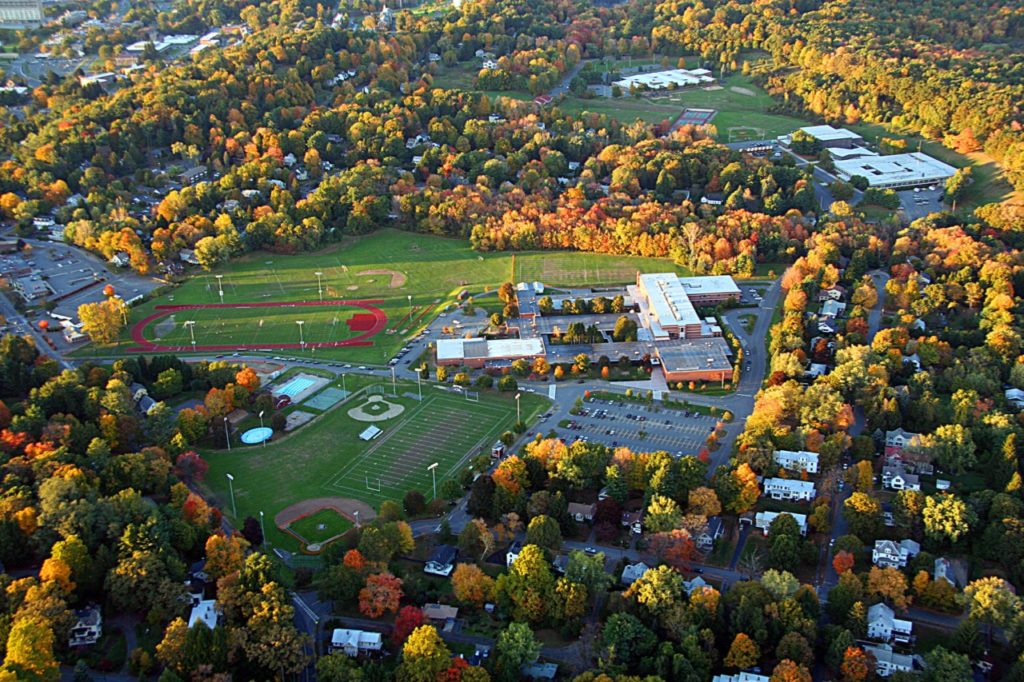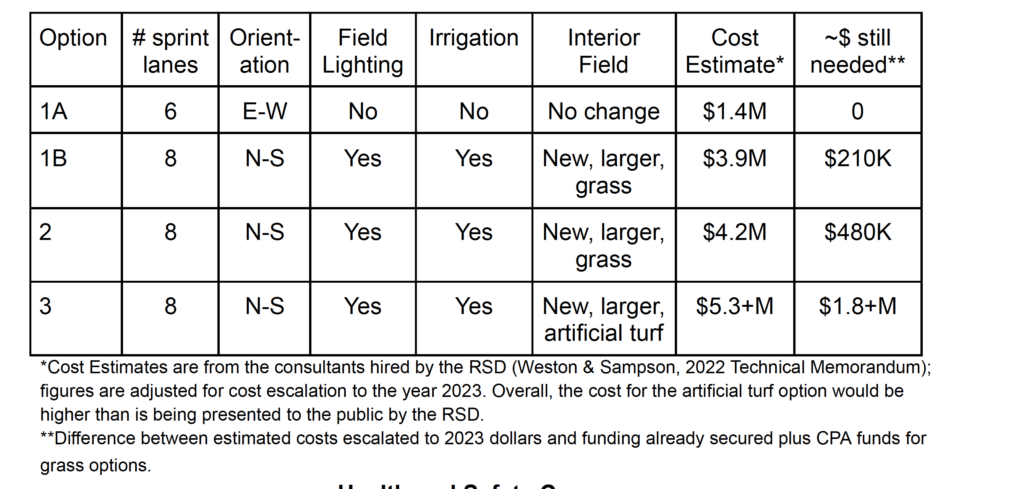Shutesbury Town Meeting Says No To Artificial Turf At Regional High School

Athletic Fields at Amherst Regional High School and Amherst Regional Middle School. Photo: Chris Condit
Shutesbury Town Meeting voted overwhelmingly last Saturday (6/3) to endorse a citizen petition stating:
“that the Town of Shutesbury does not support of the use of artificial turf for the proposed Amherst Regional High School Track and Field Project and therefore instructs the Shutesbury representative to the Amherst-Pelham Regional School Committee to inform the Regional School Committee of the Town’s position, and if the representative is given the opportunity to vote on the matter, that the representative support the Town’s wishes by voting for Option 1 or 2, or take any other relevant action there-of.”
Option 1 would involve restoration of the track in its current location and without expansion to 8 lanes and without any infield improvements. Option 2 would involve reorientation and repair and expansion of the track to eight lanes and the installation of a new and improved grass infield. Option 3, the only option currently being considered by the Regional School Committee, would reorient, repair, and expand the track and install a new artificial turf infield.
The Amherst Town Council voted (10-2-1) on December 5 to allocate $900,000 from FY 2023 free cash to support the redesign of the high school track and its enclosed field, with a provision that the school committee would have the option to install either synthetic turf or natural grass on the infield.
The full wording of the petition (Article 33) can be found here.
Shutesbury Town Meeting joins Pelham Town Meeting in rejecting the use of artificial turf and endorsing installation of a natural grass field at Amherst Regional High School (ARHS). Previously, the boards of health of all four towns in the school district (Amherst, Leverett, Pelham and Shutesbury) have each recommended unanimously against the use of artificial turf at the high school, citing both public health and environmental hazards associated with artificial turf.
Arguments Supporting The Petition
Shutesbury resident Mary Jo Johnson presented the petition noting the well-documented dangers of turf, the proliferation of legislation prohibiting its use, and the budget challenges of completing the project. She noted that the district currently has enough money in hand to renovate and reorient the track with a natural grass infield but that raising the necessary funds for turf will likely require a delay of several more years. Her arguments follow:
Financial Feasibility
The Regional School District (RSD) is well over $1.8M short of the estimated initial cost of the artificial turf project, and there is no plan for the nearly $1M maintenance and replacement costs required every decade thereafter. The RSD already has the money to resurface the track now and nearly all necessary funds for grass options (see below). Until the funding is secured, the project is on hold, perhaps indefinitely. The longer the delays, the higher the eventual costs for any option. Fundraising for this project continues to lag. Leverett and Pelham Community Preservation Act (CPA) funds were denied because of the artificial turf but both committees encouraged resubmission for grass options. The Shutesbury CPA application was withdrawn without explanation at the last minute. Private fundraising to date has only secured ~$61K (according to the latest report to the RSD).

Health and Safety Concerns
The materials used in artificial turf contain several toxins including carcinogens, heavy metals, volatile organic compounds, phthalates, polyaromatic hydrocarbons, endocrine disruptors, and neurotoxins. PFAS, the class of “forever chemicals”, are just one of several toxins to which users of these fields would be exposed, and which would also contaminate surrounding soils and water bodies. Users would also be exposed to the microbicides and disinfectants required to maintain an artificial turf field.
Communities with artificial turf, such as the City of Portsmouth, NH, have learned the hard way that artificial turf is contaminating groundwater across the country. There is no known PFAS-free artificial turf as the chemicals are an intrinsic part of the plastics manufacturing process. Claims of “safe” products represent selective testing by manufacturers of the thousands of chemicals in this class of toxins. Cities across the country, including Boston, are banning new artificial turf fields for these reasons.
Injury rates on artificial turf fields are higher than for grass fields, including skin
abrasions and infections, orthopedic injuries, concussions, and heat-related illness from the significantly higher surface temperatures experienced on these fields. Professional sports teams nation-wide are pivoting away from artificial turf for these reasons.
Sustainability and Environmental Impacts
The approximately 20 tons of non-recyclable plastic used in an artificial field of this size is made of petrochemicals (fossil fuels) that break down into microplastics that are also then released into the environment. The artificial carpet must be replaced every decade, resulting in an endless cycle of production and breakdown of these substances with no safe way to dispose of or remove them. There is no operational artificial turf recycling facility in the U.S.. The burning of these products releases the PFAS into the atmosphere and the dumping of degraded carpets contaminates other communities.
The ARHS fields are built atop wetlands, including the Tan Brook. Chemical leaching from an artificial turf will inevitably contaminate the adjacent wetlands and neighboring properties.
Climate impacts of artificial turf include heat island effects (temperatures can exceed 150°F), biome destruction, greenhouse gas emissions, and lack of CO2 sequestration (as would occur on a grass field). These impacts far outweigh the potential impacts of natural grass maintenance, which can be managed organically as Springfield does.
The Uncertain Future of Artificial Turf
Several bills in the current Massachusetts state legislature (e.g. (MA S 2053) would ban both artificial turf fields and any products containing PFAS. If they pass, as they have in other states and municipalities, the artificial turf option would become impossible. Given the uncertain regulatory future for artificial turf and its many negative impacts, we need to choose a different approach to repair the ARHS fields. A natural grass option, properly constructed and maintained, can meet everyone’s needs at far less expense and risk.
Additional References on the ARHS track and field renovation.
